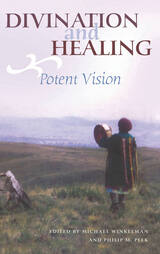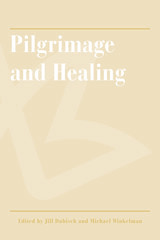2 books by Winkelman, Michael

Divination and Healing
Potent Vision
Edited by Michael Winkelman and Philip M. Peek
University of Arizona Press, 2004
Divination is an important feature of cultures all over the world. While some may still question the efficacy of divination systems, they continue to serve their communities by diagnosing ailments, prescribing healing treatments, and solving problems. Yet despite their universality, there are relatively few comprehensive studies of divination systems. This volume seeks to fill this gap regarding the use of divination in healing. Here some of the world’s leading authorities draw on their own fieldwork and participation in ritual to present detailed case studies, demonstrating that divination rituals can have therapeutic effects. As the contributors examine the systems of knowledge that divination articulates and survey the varieties of divinatory experience, they seek to analyze divination as an epistemological system, as a social process, and as a therapeutic endeavor. While some of their findings reinforce traditional assumptions about the importance of social control, spirit relations, and community support in the divination process, the authors place these considerations within new epistemological frameworks that emphasize the use of alternative modes of knowing. In this wide-ranging volume, readers will find coverage of classic Ifa systems; Buddhist-influenced shamanic practices in the former Soviet Union; the reconciliation of Muslim beliefs and divinatory practices in Thailand; Native American divination used in diagnosis; Maya calendrical divination in Guatemala; mediumistic and chicken oracle divination among the Sukuma of Tanzania; Ndembu divination, focusing on the process of collective healing; and divination among the Samburu (Maasai) of Kenya, featuring dialogues from actual healing sessions. Together, these contributions argue for new perspectives on the study of divination that emphasize not only the epistemological roots of these systems but also their multifaceted therapeutic functions. Divination and Healing is a rich source of both data and insight for scholars of ritual, religion, medical anthropology, and the psychology of altered states of consciousness.
[more]

Pilgrimage and Healing
Edited by Jill Dubisch and Michael Winkelman
University of Arizona Press, 2005
Bikers converge at the Vietnam Veterans Memorial in Washington, D.C. Thousands flock to a Nevada desert to burn a towering effigy. And the hopeless but hopeful ill journey to Lourdes as they have for centuries. Although pilgrimage may seem an antiquated religious ritual, it remains a vibrant activity in the modern world as pilgrims combine traditional motives—such as seeking a cure for physical or spiritual problems—with contemporary searches for identity or interpersonal connection. That pilgrimage continues to exercise such a strong attraction is testimony to the power it continues to hold for those who undertake these sacred journeys.
This volume brings together anthropological and interdisciplinary perspectives on these persistent forms of popular religion to expand our understanding of the role of the traditional practice of pilgrimage in what many believe to be an increasingly secular world. Focusing on the healing dimensions of pilgrimage, the authors present case studies grounded in specific cultures and pilgrimage traditions to help readers understand the many therapeutic resources pilgrimage provides for people around the world. The chapters examine a variety of pilgrimage forms, both religious and non-religious, from Nepalese and Huichol shamanism pilgrimage to Catholic journeys to shrines and feast days to Nevada’s Burning Man festival. These diverse cases suggest a range of meanings embodied in the concept of healing itself, from curing physical ailments and redefining the self to redressing social suffering and healing the wounds of the past.
Collectively and individually, the chapters raise important questions about the nature of ritual in general, and healing through pilgrimage in particular, and seek to illuminate why so many participants find pilgrimage a compelling way to address the problem of suffering. They also illustrate how pilgrimage exerts its social and political influence at the personal, local, and national levels, as well as providing symbols and processes that link people across social and spiritual boundaries. By examining the persistence of pilgrimage as a significant source of personal engagement with spirituality, Pilgrimage and Healing shows that the power of pilgrimage lies in its broad transformative powers. As our world increasingly adopts a secular and atheistic perspective in many domains of experience, it reminds us that, for many, spiritual quest remains a potent force.
This volume brings together anthropological and interdisciplinary perspectives on these persistent forms of popular religion to expand our understanding of the role of the traditional practice of pilgrimage in what many believe to be an increasingly secular world. Focusing on the healing dimensions of pilgrimage, the authors present case studies grounded in specific cultures and pilgrimage traditions to help readers understand the many therapeutic resources pilgrimage provides for people around the world. The chapters examine a variety of pilgrimage forms, both religious and non-religious, from Nepalese and Huichol shamanism pilgrimage to Catholic journeys to shrines and feast days to Nevada’s Burning Man festival. These diverse cases suggest a range of meanings embodied in the concept of healing itself, from curing physical ailments and redefining the self to redressing social suffering and healing the wounds of the past.
Collectively and individually, the chapters raise important questions about the nature of ritual in general, and healing through pilgrimage in particular, and seek to illuminate why so many participants find pilgrimage a compelling way to address the problem of suffering. They also illustrate how pilgrimage exerts its social and political influence at the personal, local, and national levels, as well as providing symbols and processes that link people across social and spiritual boundaries. By examining the persistence of pilgrimage as a significant source of personal engagement with spirituality, Pilgrimage and Healing shows that the power of pilgrimage lies in its broad transformative powers. As our world increasingly adopts a secular and atheistic perspective in many domains of experience, it reminds us that, for many, spiritual quest remains a potent force.
[more]
READERS
Browse our collection.
PUBLISHERS
See BiblioVault's publisher services.
STUDENT SERVICES
Files for college accessibility offices.
UChicago Accessibility Resources
home | accessibility | search | about | contact us
BiblioVault ® 2001 - 2024
The University of Chicago Press









